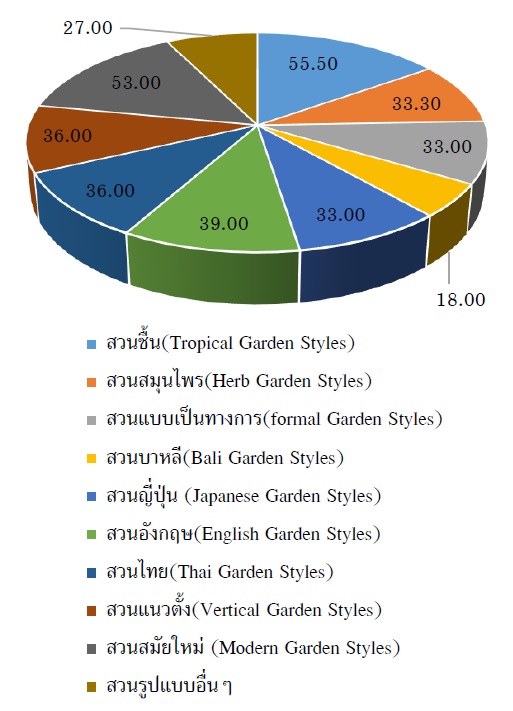The Study of New Normal Landscape Design Based on the Spreading of COVID-19 Pandemics in Thailand
Keywords:
Landscape design, New normal life, The spreading of COVID-19 pandemicAbstract
The objectives of this research were to study factors affecting changes in landscape design patterns and to propose landscape design guidelines in new normal life based on the spreading of the Covid-19 pandemic in Thailand. In this study, data was collected from landscape officers, freelance landscape designers, online data from yellow page (landscape design office/garden design) including co-careers in the landscape industry using both online and offline questionnaires based on quantitative methodology. Descriptive statistic data were analyzed by statistical package for social science (SPSS) of percentage, mean, and standard deviation. The results found that the most effective factors that changed the landscape design patterns during the pandemic of COVID-19 were socio-economic (67.00%). This COVID-19 situation also affected changes in landscape design with a value of 54%, while having a small impact on the landscape industry (70%). However, only 19% showed no impact of COVID-19 on their business. The results indicated that the landscape design concept needed to consider the spacing design to create the perception of open spaces, better air and ventilation and more comfort. Activities and facilities design should be safe with spacing of personal distancing at least 6 feet or 2 meters. Conceptual design should be concentrated on cost saving, plant selections such as herbs or extremophiles that can be easy to maintain.
References
กรมควบคุมโรค กระทรวงสาธารณสุข. สถานการณ์ผู้ติดเชื้อ COVID-19 อัพเดทรายวัน.[อินเตอร์เน็ต]. [เข้าถึงเมื่อวันที่ 20 ธันวา คม 2564]. เข้าถึงได้จาก https://covid19.ddc.moph.go.th/
ประกายดาว แบ่งสันเที๊ยะ. สถานการณ์โควิด 19.หนังสือพิมพ์กรุงเทพธุรกิจ [อินเตอร์เน็ต]. 2563 [เข้าถึงเมื่อวันที่ 27 กรกฎาคม 2564].เข้าถึงได้ https://www.bangkokbiznews.com/business/903495
เดชา บุญค้ำ. การปฏิบัติวิชาชีพภูมิสถาปัตยกรรม. พิมพ์ครั้งที่ 3. กรุงเทพฯ: ศูนย์หนังสือจุฬาลงกรณ์จุฬาลงกรณ์มหาวิทยาลัย; 2537.
ประภาพร ธาราสายทอง. ภูมิทัศน์เพื่อการบำบัดจิต [วิทยานิพนธ์ ภูมิสถาปัตยกรรม]. กรุงเทพฯ:จุฬาลงกรณ์มหาวิทยาลัย; 2546.
Nitayaporn M. New Normal ชีวิตวิถีใหม่.บทความด้านสุขภาพจิต กรมสุขภาพจิต[อินเตอร์เน็ต]. 2563 [เข้าถึงเมื่อวันที่ 10 ธันวาคม 2564]. เข้าถึงได้จาก https://www.dmh.go.th/news/view.asp?id=2288
พีรพัฒน์ ใจแก้วมา. การศึกษาพฤติกรรมการดำรงชีวิตแบบปรกติใหม่ของประชาชนชาวไทยระหว่างวิกฤตโควิด-19ที่ปรากฎในสื่อออนไลน์. [วิทยานิพนธ์ระดับปริญญาตรี]. พิษณุโลก:มหาวิทยาลัยนเรศวร; 2563.
กองโรคจากการประกอบอาชีพและสิ่งแวดล้อม กรมควบคุมโรค กระทรวงสาธารณสุข. มาตรการการดำเนินงาน เฝ้าระวัง ป้องกัน ควบคุมโรคติดเชื้อไวรัสโคโรนา 2019 สำหรับพัฒนา “สถานที่ทำงานต้านโควิด19 ในฐานวิถีชีวิตใหม่: New Normal” [อินเตอร์เน็ต]. 2563 [เข้าถึงเมื่อวันที่ 10 ธันวาคม 2564]. เข้าถึงได้จาก https://ddc.moph.go.th/uploads/publish/1119620210315035004.pdf
รมย์ชลีรดา ด่านวันดี. เอกสารคำสอนการออกแบบวางผังพืชพรรณ. พิมพ์ครั้งแรก. เชียงใหม่:สำนักพิมพ์มหาวิทยาลัยแม่โจ้; 2559.
สุนทร บุญญาธิการ. เทคนิคการออกแบบบ้านประหยัดพลังงาน เพื่อคุณภาพชีวิตที่ดีกว่า.พิมพ์ครั้งที่ 1. กรุงเทพฯ: สำนักพิมพ์แห่งจุฬาลงกรณ์มหาวิทยาลัย; 2542.
ภัทรนันท์ ทักขนนท์. สภาวะน่าสบาย: พื้นฐานและแบบจำลองสำหรับภูมิอากาศร้อนชื้น. วารสารหน้าจั่ว 2547-2548;21:133-46.
Booth NK. Basic Element of Landscape Architectural Design. USA: Department of Landscape Architecture, Ohio State University; 1983; 439-45.
Taro Y. Statistic: An Introduction Analysis. 3rd Edition. New York: Harper and Row; 1973.
แคตตาล็อกออนไลน์. หมวดหมู่: สำนักงานออกแบบ, กลุ่มนักออกแบบภูมิทัศน์อิสระ.[อินเตอร์เน็ต]. [เข้าถึงเมื่อวันที่ 9 กรกฎาคม 2564]. เข้าถึงได้จาก www.yellowpages.com
คณะสถาปัตยกรรมศาสตร์และการออกแบบสิ่งแวดล้อม มหาวิทยาลัยแม่โจ้.รายชื่อสถานประกอบการสหกิจศึกษา: งานบริการการศึกษา; 2564.
วิมลสิทธิ์ หรยางกูร. พฤติกรรมมนุษย์กับสภาพแวดล้อมมูลฐานทางพฤติกรรมเพื่อการออกแบบและวางแผน. พิมพ์ครั้งที่ 4. กรุงเทพฯ:โรงพิมพ์จุฬาลงกรณ์มหาวิทยาลัย; 2537.

Downloads
Published
Issue
Section
License
บทความทุกบทความที่ตีพิมพ์ในวารสารการพัฒนางานประจำสู่งานวิจัย (JPR2R) ถือว่าเป็นลิขสิทธิ์ของวารสารการพัฒนางานประจำสู่งานวิจัย คณะสิ่งแวดล้อมและทรัพยากรศาสตร์ มหาวิทยาลัยมหิดล





